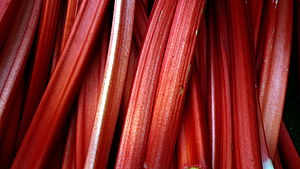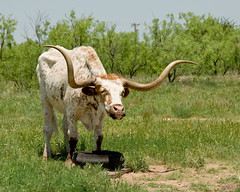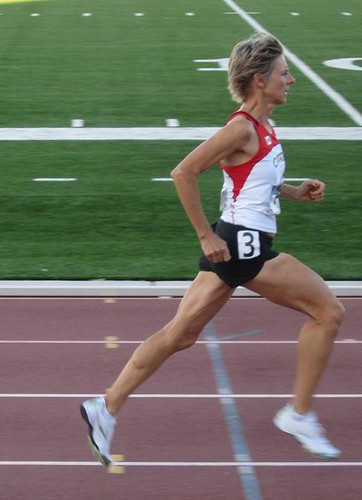 You’ve survived the holiday season – regardless of which holiday(s) you were celebrating. You might have put forth some resolutions for the upcoming year. You are feeling rejuvenated by the first few days of the new year. If you are in Austin, you have even been celebrating 70 degree weather in January – a treat, to say the least.
You’ve survived the holiday season – regardless of which holiday(s) you were celebrating. You might have put forth some resolutions for the upcoming year. You are feeling rejuvenated by the first few days of the new year. If you are in Austin, you have even been celebrating 70 degree weather in January – a treat, to say the least.
One thing never changes though – the growth of fresh rhubarb. There will always be news which reminds us that truth is stranger than fiction. The first new rhubarb for 2012 is upon us. Imagine this – it is chock full of politics and yummy vitamins. Enjoy Episode 31, the first episode of 2012!
 I have written a series of posts and created a number of podcasts over the years entitled “Consumer’s Guide To Health” (CGH). The long-term goal has always been to promote consumer awareness, provide resources for competent self care strategies, and to gradually shift our system of health and the accepted standards of care towards evidence-based principles. It has also attempted to debunk many health myths.
I have written a series of posts and created a number of podcasts over the years entitled “Consumer’s Guide To Health” (CGH). The long-term goal has always been to promote consumer awareness, provide resources for competent self care strategies, and to gradually shift our system of health and the accepted standards of care towards evidence-based principles. It has also attempted to debunk many health myths.
These myths exists in clinical practice: in the assessment and treatment of patients. They also exist in the coaching and training world, where many training “theories” continue to have little to no relevant sports science at their root.
The live streaming CGH podcasts will resume on January 19, 2012. I will also be focusing a series of episodes and posts specifically on training myths. Here is an abbreviated list of some upcoming topics that will get you thinking:
 The temperature in Austin dropped below freezing last night. Pretty chilly, indeed.
The temperature in Austin dropped below freezing last night. Pretty chilly, indeed.
It’s funny saying that, having grown up in Canada with my share of Canadian winters. Having now lived in Austin for over 20 years, it always amazes me what now constitutes “chilly”. The natives here tell me that your blood thins out when you live here a while. I don’t know if my blood is any thinner, but I know my feet get cold faster than ever.
A Canadian winter is something I will never forget. Winters in Eastern Ontario are a far cry from those experienced in Lotusland (aka Vancouver, British Columbia – otherwise known as Hollywood North). Living along the St. Lawrence River, you are just a stone’s throw from the snow belt – when a trip due south in perfectly clear conditions becomes a white out in a heartbeat.
Winter sounds enchanting, doesn’t it? You can go downhill skiing, or cross country skiing, or snowboarding, or sledding, or ice skating, or go curling or even play some hockey. It always sounds delightful - until you are faced with its icy grip for, oh, about 6 or 7 solid months, if not longer.
 It is that time of year again – time for people to make New Year’s Resolutions. Most will resolve to become happier and more productive in the coming year. But for many, New Year’s resolutions end up becoming "health resolutions".
It is that time of year again – time for people to make New Year’s Resolutions. Most will resolve to become happier and more productive in the coming year. But for many, New Year’s resolutions end up becoming "health resolutions".
At this time of year, you will often hear the refrain of "I am going to lose a little weight” or “I am going to eat healthier”. I am sure we've all made resolutions along those lines, and I am sure that many of us have failed in our attempts.
Many times, we are unsuccessful with our resolutions because of the strategies we use to accomplish our goals. The problem can lie in using the same unsuccessful approach year in and year out. As they say, “if you do what you’ve done, you will get what you’ve got”.
With that in mind, here are three interviews from “Consumer’s Guide To Health” that will help. They examine health resolutions and the basics of both fitness and nutrition. Make 2012 the year when you set reasonable goals and put effective strategies into place to make them a reality.
 It is hard to believe that the end of 2011 is upon us. Over the past year, I challenged myself to write more, and more consistently. I managed to accomplish this goal – writing 181 posts and articles (including the piece you are consuming right now). What this amounts to is about 1700 words per week. Prior to 2011, my most productive writing year was 2008 when I posted a mere 72 articles.
It is hard to believe that the end of 2011 is upon us. Over the past year, I challenged myself to write more, and more consistently. I managed to accomplish this goal – writing 181 posts and articles (including the piece you are consuming right now). What this amounts to is about 1700 words per week. Prior to 2011, my most productive writing year was 2008 when I posted a mere 72 articles.
Writing has not just been limited to blogging. This spring saw the completion of a book chapter (co-authored with Bridget Clark, PT) entitled “Running Injuries: Etiology And Recovery-Based Treatment” which appears in the recently released third edition of "Clinical Orthopaedic Rehabilitation: An Evidence-Based Approach" by S. Brent Brotzman, MD and Robert C. Manske, PT. In the upcoming year, there are a number of writing projects brewing – both non-fiction and fiction.
The number of readers of this blog has grown significantly over the past year as well. I am always flattered and humbled that you, the reader, have taken the time during your day to stop by this website.
As far as projects go, most notably the Smart Life Project, exciting things are ahead for 2012. This site will become the home of discussion forums and groups related to the Smart Life Project. I hope that you will continue to participate in the discussions that directly affect our system of health in this country and competent self care globally. Together, we can change the world.
With much fanfare, here are my top 13 posts of 2011 (initials in parentheses indicate the category – Rhubarb Diaries or Smart Physio):
 It was with great anticipation that we began the 2011 college football season here in Austin. What would the Longhorns look like this year? Gone were the days of Greg Davis. Will Muschamp decided that a head coaching job in the Swamp was better than waiting for Mack brown to retire. With new offensive and defensive coordinators, 2011 was a fresh start.
It was with great anticipation that we began the 2011 college football season here in Austin. What would the Longhorns look like this year? Gone were the days of Greg Davis. Will Muschamp decided that a head coaching job in the Swamp was better than waiting for Mack brown to retire. With new offensive and defensive coordinators, 2011 was a fresh start.
Although the Longhorns ended the season on a slump, they did get a big ego boost (and win-for-the-ages) against Texas A&M. A 7 – 5 record also “earned” them a bowl bid. It was onwards to San Diego for the Holiday Bowl against the 7 – 5 Cal Golden Bears.
On paper, this game looked, well, pedestrian at best. In reality, the game was, well, pedestrian at best. But this game did serve as a great season summary of the 2011 Longhorns.
 This is the sixth in a series of RunSmart videos. The series is on-going, with a new video released on a biweekly basis. These videos complement the material presented in the book “RunSmart: A Comprehensive Approach To Injury-Free Running”. The full series of videos can be found here. A transcription of the video will also be available with each post.
This is the sixth in a series of RunSmart videos. The series is on-going, with a new video released on a biweekly basis. These videos complement the material presented in the book “RunSmart: A Comprehensive Approach To Injury-Free Running”. The full series of videos can be found here. A transcription of the video will also be available with each post.
For those of you that are interested in a more interactive learning environment, consider attending a RunSmart Level One, Level Two, or Level Three program. Level One focuses on Principles, Level Two on Performance and Training Program Development, and Level Three on Physiotherapy and Running Injury Recovery. CCU credit for physical therapists is available for Level One (3.5 CCU), and is pending for the complete program (13.1 CCU). Further CCU details will follow as they are available.
In this video, I will discuss what I call the “no fly zone”. There is a tendency for runners to emphasize the aspects of their running gait that are in front of their body, though the propulsive phase of gait is that which is primarily responsible for moving the body forward. The “no fly zone” is the area on the front side of the body which has typically been the focus for arm and leg swing.
I hope you enjoy the video series. If you would like me to address any specific aspect of the RunSmart approach, drop me an email or add a comment to this article.
 "Running Injuries: Etiology And Recovery- Based Treatment" (co-author Bridget Clark, PT) appears in the third edition and fourth editions of "Clinical Orthopaedic Rehabilitation: A Team Approach" by Charles Giangarra, MD and Robert C. Manske, PT.
"Running Injuries: Etiology And Recovery- Based Treatment" (co-author Bridget Clark, PT) appears in the third edition and fourth editions of "Clinical Orthopaedic Rehabilitation: A Team Approach" by Charles Giangarra, MD and Robert C. Manske, PT.
 Allan Besselink, PT, DPT, Ph.D., Dip.MDT has a unique voice in the world of sports, education, and health care. Read more about Allan here.
Allan Besselink, PT, DPT, Ph.D., Dip.MDT has a unique voice in the world of sports, education, and health care. Read more about Allan here.
 Top 5 finalist in three categories: "Best Overall Blog", "Best PT Blog" and "Best Advocacy Blog".
Top 5 finalist in three categories: "Best Overall Blog", "Best PT Blog" and "Best Advocacy Blog".